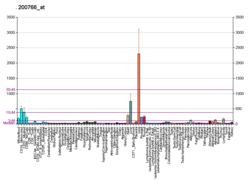Cathepsin D is a protein that in humans is encoded by the CTSD gene.[5][6] This gene encodes a lysosomal aspartyl protease composed of a protein dimer of disulfide-linked heavy and light chains, both produced from a single protein precursor. Cathepsin D is an aspartic endo-protease that is ubiquitously distributed in lysosomes.[7] The main function of cathepsin D is to degrade proteins and activate precursors of bioactive proteins in pre-lysosomal compartments.[8] This proteinase, which is a member of the peptidase A1 family, has a specificity similar to but narrower than that of pepsin A. Transcription of the CTSD gene is initiated from several sites, including one that is a start site for an estrogen-regulated transcript. Mutations in this gene are involved in the pathogenesis of several diseases, including breast cancer and possibly Alzheimer disease.[6] Homozygous deletion of the CTSD gene leads to early lethality in the postnatal phase.[9] Deficiency of CTSD gene has been reported an underlying cause of neuronal ceroid lipofuscinosis (NCL).[10]
- ^ a b c GRCh38: Ensembl release 89: ENSG00000117984 – Ensembl, May 2017
- ^ a b c GRCm38: Ensembl release 89: ENSMUSG00000007891 – Ensembl, May 2017
- ^ "Human PubMed Reference:". National Center for Biotechnology Information, U.S. National Library of Medicine.
- ^ "Mouse PubMed Reference:". National Center for Biotechnology Information, U.S. National Library of Medicine.
- ^ Faust PL, Kornfeld S, Chirgwin JM (August 1985). "Cloning and sequence analysis of cDNA for human cathepsin D". Proceedings of the National Academy of Sciences of the United States of America. 82 (15): 4910–4. Bibcode:1985PNAS...82.4910F. doi:10.1073/pnas.82.15.4910. PMC 390467. PMID 3927292.
- ^ a b "Entrez Gene: CTSD cathepsin D".
- ^ Barrett AJ (April 1970). "Cathepsin D. Purification of isoenzymes from human and chicken liver". The Biochemical Journal. 117 (3): 601–7. doi:10.1042/bj1170601. PMC 1178965. PMID 5419752.
- ^ Diment S, Martin KJ, Stahl PD (August 1989). "Cleavage of parathyroid hormone in macrophage endosomes illustrates a novel pathway for intracellular processing of proteins". The Journal of Biological Chemistry. 264 (23): 13403–6. doi:10.1016/S0021-9258(18)80010-2. PMID 2760027.
- ^ Saftig P, Hetman M, Schmahl W, Weber K, Heine L, Mossmann H, Köster A, Hess B, Evers M, von Figura K (August 1995). "Mice deficient for the lysosomal proteinase cathepsin D exhibit progressive atrophy of the intestinal mucosa and profound destruction of lymphoid cells". The EMBO Journal. 14 (15): 3599–608. doi:10.1002/j.1460-2075.1995.tb00029.x. PMC 394433. PMID 7641679.
- ^ Ramirez-Montealegre D, Rothberg PG, Pearce DA (June 2006). "Another disorder finds its gene". Brain. 129 (Pt 6): 1353–6. doi:10.1093/brain/awl132. PMID 16738059.






